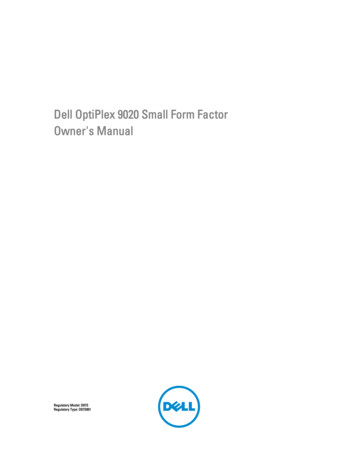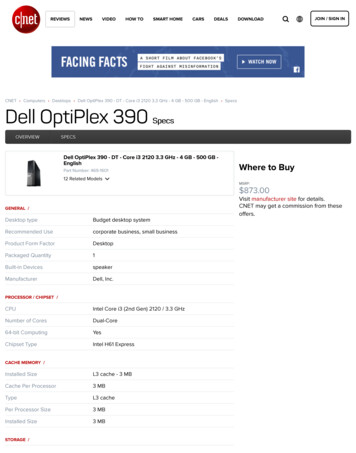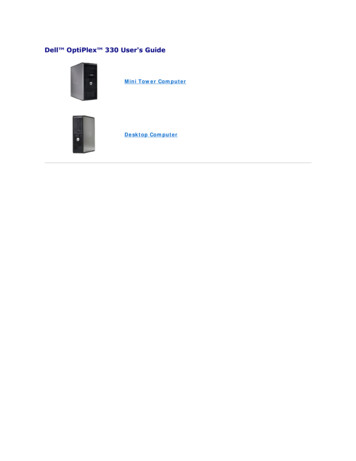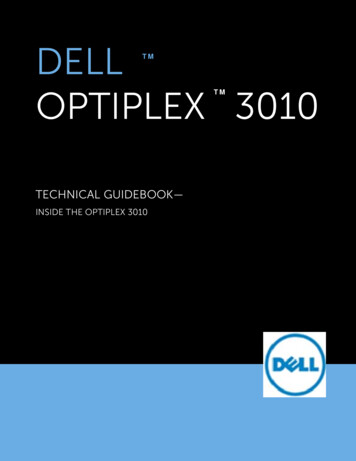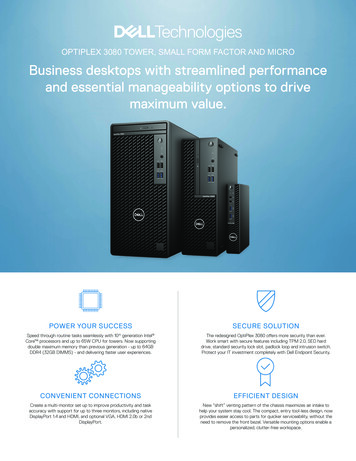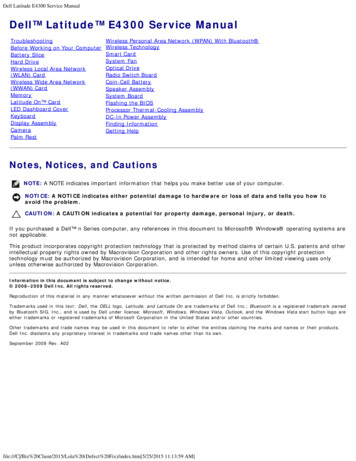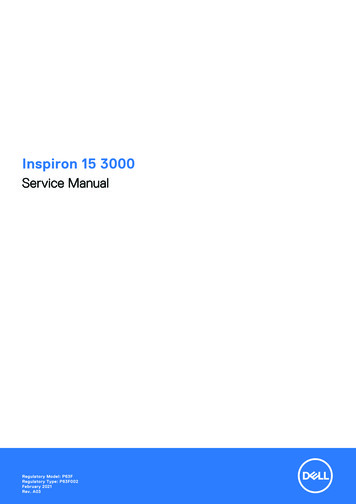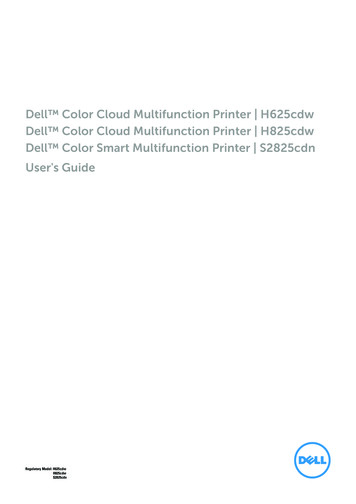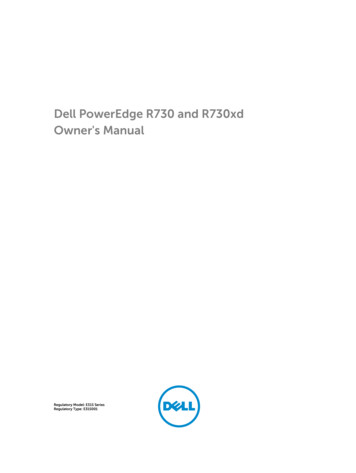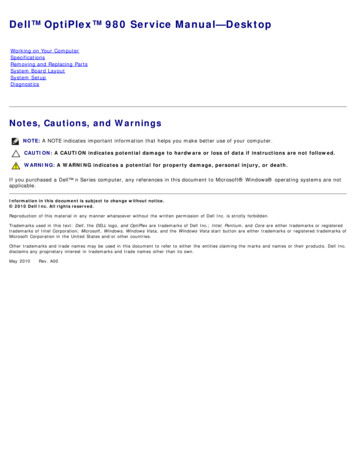
Transcription
Dell OptiPlex 980 Service Manual—DesktopWorking on Your ComputerSpecificationsRemoving and Replacing PartsSystem Board LayoutSystem SetupDiagnosticsNotes, Cautions, and WarningsNOTE: A NOTE indicates important information that helps you make better use of your computer.CAUTION: A CAUTION indicates potential damage to hardware or loss of data if instructions are not followed.WARNING: A WARNING indicates a potential for property damage, personal injury, or death.If you purchased a Dell n Series computer, any references in this document to Microsoft Windows operating systems are notapplicable.Information in this document is subject to change without notice. 2010 Dell Inc. All rights reserved.Reproduction of this material in any manner whatsoever without the written permission of Dell Inc. is strictly forbidden.Trademarks used in this text: Dell, the DELL logo, and OptiPlex are trademarks of Dell Inc.; Intel, Pentium, and Core are either trademarks or registeredtrademarks of Intel Corporation; Microsoft, Windows, Windows Vista, and the Windows Vista start button are either trademarks or registered trademarks ofMicrosoft Corporation in the United States and/or other countries.Other trademarks and trade names may be used in this document to refer to either the entities claiming the marks and names or their products. Dell Inc.disclaims any proprietary interest in trademarks and trade names other than its own.May 2010 Rev. A00
Back to Contents PageWorking on Your ComputerDell OptiPlex 980 Service Manual—DesktopBefore Working Inside Your ComputerRecommended ToolsTurning Off Your ComputerAfter Working Inside Your ComputerBefore Working Inside Your ComputerUse the following safety guidelines to help protect your computer from potential damage and to help to ensure your personalsafety. Unless otherwise noted, each procedure included in this document assumes that the following conditions exist:You have read the safety information that shipped with your computer.A component can be replaced or—purchased separately—installed by performing the removal procedure in reverseorder.WARNING: Before working inside your computer, read the safety information that shipped with yourcomputer. For additional safety best practices information, see the Regulatory Compliance Homepage atwww.dell.com/regulatory compliance.CAUTION: Many repairs may only be done by a certified service technician. You should only performtroubleshooting and simple repairs as authorized in your product documentation, or as directed by theonline or telephone service and support team. Damage due to servicing that is not authorized by Dell isnot covered by your warranty. Read and follow the safety instructions that came with the product.CAUTION: To avoid electrostatic discharge, ground yourself by using a wrist grounding strap or byperiodically touching an unpainted metal surface, such as a connector on the back of the computer.CAUTION: Handle components and cards with care. Do not touch the components or contacts on a card.Hold a card by its edges or by its metal mounting bracket. Hold a component such as a processor by itsedges, not by its pins.CAUTION: When you disconnect a cable, pull on its connector or on its pull-tab, not on the cable itself.Some cables have connectors with locking tabs; if you are disconnecting this type of cable, press in on thelocking tabs before you disconnect the cable. As you pull connectors apart, keep them evenly aligned toavoid bending any connector pins. Also, before you connect a cable, ensure that both connectors arecorrectly oriented and aligned.NOTE: The color of your computer and certain components may appear differently than shown in this document.To avoid damaging your computer, perform the following steps before you begin working inside the computer.1. Ensure that your work surface is flat and clean to prevent the cover from being scratched.2. Turn off your computer (see Turning Off Your Computer).CAUTION: To disconnect a network cable, first unplug the cable from your computer and then unplug thecable from the network device.3.4.5.6.Disconnect all network cables from the computer.Disconnect your computer and all attached devices from their electrical outlets.Press and hold the power button while the computer is unplugged to ground the system board.Remove the cover.CAUTION: Before touching anything inside your computer, ground yourself by touching an unpainted metalsurface, such as the metal at the back of the computer. While you work, periodically touch an unpaintedmetal surface to dissipate static electricity, which could harm internal components.
Recommended ToolsThe procedures in this document may require the following tools:Small flat-blade screwdriverPhillips screwdriverSmall plastic scribeFlash BIOS update program mediaTurning Off Your ComputerCAUTION: To avoid losing data, save and close all open files and exit all open programs before you turn offyour computer.1. Shut down the operating system:In Windows 7:Click Start, then click Shut Down.In Windows Vista :Click StartShut Down., then click the arrow in the lower-right corner of the Start menu as shown below, and then clickIn Windows XP:Click Start Turn Off Computer Turn Off.The computer turns off after the operating system shutdown process is complete.2. Ensure that the computer and all attached devices are turned off. If your computer and attached devices did notautomatically turn off when you shut down your operating system, press and hold the power button for about 6seconds to turn them off.After Working Inside Your ComputerAfter you complete any replacement procedure, ensure you connect any external devices, cards, and cables before turning onyour computer.1. Replace the cover.CAUTION: To connect a network cable, first plug the cable into the network device and then plug it into thecomputer.2.3.4.5.Connect any telephone or network cables to your computer.Connect your computer and all attached devices to their electrical outlets.Turn on your computer.Verify that the computer works correctly by running the Dell Diagnostics.Back to Contents Page
Back to Contents PageTechnical SpecificationsProcessorControls and LightsMemoryNetworkExpansion BusAudioVideoPowerSystem InformationSystem Board ConnectorsCardsPhysicalDrivesEnvironmentalExternal ConnectorsNOTE: Offerings may vary by region. For more information regarding the configuration of your computer, click Start Help and Support and select the option to view information about your computer.NOTE: Unless otherwise stated, the specifications are identical for mini-tower, desktop, and small form factorcomputers.ProcessorTypeQuad-CoreIntel Core i7 seriesIntel Core i5 seriesDual-CoreIntel Core i5 seriesIntel Core i3 seriesIntel Pentium Level 2 (L2) cacheIntel Core i7 seriesIntel Core i5 series8 MBIntel Core i5 seriesIntel Core i3 series4 MBIntel Pentium3 MBMemoryTypeDDR3 SDRAM (non-ECC memory only)Speed1066 MHz or 1333 MHzConnectorsfourCapacity1 GB, 2 GB, or 4 GBMinimum memory1 GBMaximum memory16 GBVideoIntegratedIntel graphics media accelerator HDNOTE: Not supported by computersshipped withIntel i7 and Intel i5 quad-core processors.DiscretePCI Express x16 slot supports a PCIExpress card
Memory - IntegratedUp to 1759 MB shared video memory(total system memory greater than 512MB)AudioIntegratedIntel high definition audioNetworkIntegratedIntegrated Intel 82578DM GigabitEthernet capable of 10/100/1000 Mb/scommunicationSystem InformationChipsetIntel Q57 Express chipsetDMA channelseightInterrupt levels24BIOS chips (NVRAM)64 Mb and 16 MbExpansion BusBus typePCI 2.3PCI Express 2.0SATA 1.0A and 2.0eSATAUSB 2.0Bus speedPCI133 MB/sPCI Expressx1-slot (wireless only) bidirectional speed- 500 MB/sx16-slot (wired as x4) bidirectional speed- 2 GB/sx16-slot bidirectional speed - 8 GB/sSATA1.5 GB/s and 3.0 GB/seSATA3.0 GB/sUSB480 MB/sMini-towerup to two full-height cardsDesktopwithout riser card — up to two low-profilecardswith riser card — up to two full-heightcardsSmall form factorone low-profile cardCardsPCIPCI Express x16 (wired as x4)Mini-towerone full-height cardDesktopone low-profile cardSmall form factornonePCI Express x16
Mini-towerone full-height cardDesktopwithout riser card— one low-profile cardwith riser card— one full-height cardSmall form factorone low-profile cardPCI Express x1Mini-towerone wireless cardDesktopone wireless cardSmall form factorone wireless cardDrivesExternally accessible - 5.25-inch drive bay(s)Mini-towertwo baysDesktopone baySmall form factorone slimline bayExternally accessible - 3.5-inch drive bay (s)Mini-towerone bayDesktopone baySmall form factorone bayInternally accessible - 3.5 inch drive bay(s) for hard drivesMini-towertwo baysDesktopone baySmall form factorone bayNOTE: Your computer can support up to two 2.5 inch hard drives with brackets.External ConnectorsAudioBack paneltwo connectors for line-in/ microphoneand line-outFront paneltwo front-panel connectors forheadphones and microphoneeSATAone 7-pin connectorNetworkone RJ45 connectorParallelone 25-pin connector (bidirectional)Serialone 9-pin connector; 16550C-compatibleUSB - Front panelMini-towerfour connectorsDesktoptwo connectorsSmall form factortwo connectorsUSB - Back panelMini-towersix connectorsDesktopsix connectorsSmall form factorsix connectors
Videoone 15-hole VGA connectorone 20-pin DisplayPort connectorSystem Board ConnectorsPCI 2.3 data width (maximum) — 32 bitsMini-towertwo 120-pin connectorsDesktoptwo 120-pin connectorsSmall form factorone 120-pin connectorPCI Express x16 (wired as x4) data width (maximum) — four PCI Express lanesMini-towerone 164-pin connectorDesktopone 164-pin connectorSmall form factornot applicablePCI Express x16 data width (maximum) — 16 PCI Express lanesMini-towerone 164-pin connectorDesktopone 164-pin connectorSmall form factorone 164-pin connectorSerial ATAMini-towerfour 7-pin connectorsDesktopthree 7-pin connectorsSmall form factorthree 7-pin connectorsMemoryfour 240-pin connectorsInternal USBone 10-pin connector (supports two USBports)Processor fanone 5-pin connectorFront I/Oone 26-pin connectorFront panel controlone 14-pin connectorProcessorone 1156-pin connectorPower 12Vone 4-pin connectorPowerone 24-pin connectorInternal serial cardone 14-pin connectorInternal speakerone 5-pin connectorPCI Express x1 (wireless card)one 36-pin connectorThermal sensorone 2-pin connectorIntruder connectorone 3-pin connectorControls and LightsFront of the computerPower buttonpush buttonPower lightblinking blue — indicates that thecomputer is in sleep state.solid blue — indicates that the computeris in power-on state.blinking amber — indicates a problemwith the system board.solid amber (when the computer does not
start) — indicates a problem with thesystem board or power supply.Drive activity lightblinking blue — indicates that thecomputer is reading data from or writingdata to the hard drive.Network connectivity lightblue — indicates that a good connectionexists between the network and thecomputer.off (no light) — indicates that thecomputer is not detecting a physicalconnection to the network.Diagnostic lightsfour amber lights on the front panel. Formore information, see Diagnostics.Back of the computerLink integrity light on integratednetwork adaptergreen — a good 10 Mbps connectionexists between the network and thecomputer.orange — a good 100 Mbps connectionexists between the network and thecomputer.yellow — a good 1000 Mbps connectionexists between the network and thecomputer.off (no light) — the computer is notdetecting a physical connection to thenetwork.Network activity light on integratednetwork adapteryellow light — a blinking yellow lightindicates that network activity is present.Power supply lightgreen light — the power supply is turnedon and is functional. The power cablemust be connected to the powerconnector (at the back of the computer)and the electrical outlet.NOTE: You can test the health of thepower system by pressing the test button.When the system's power supply voltageis within specification, the self-test LEDlights up. If the LED does not light up, thepower supply may be defective. AC powermust be connected during this test.PowerWattageMini-tower255 W(EPA)305 W (nonEPA)Desktop255 W(EPA)255 W (nonEPA)Small form factor235 W(EPA)235 W (nonEPA)Mini-tower1000BTU/hr(EPA)1603 BTU/hr(non-EPA)Desktop1000BTU/hr(EPA)1341 BTU/hr(non-EPA)Maximum heat dissipation
Small form factor921BTU/hr(EPA)1235 BTU/hr(non-EPA)Voltage100–240 VACCoin-cell battery3 V CR2032 lithium coin cellNOTE: Heat dissipation is calculated by using the power supply wattage rating.PhysicalHeightMini-tower40.80 cm (16.06 inches)Desktop39.70 cm (15.62 inches)Small form factor29.0 cm (11.41 inches)Mini-tower18.70 cm (7.36 inches)Desktop10.90 cm (4.29 inches)Small form factor8.50 cm (3.34 inches)Mini-tower43.10 cm (16.96 inches)Desktop34.80 cm (13.70 inches)Small form factor32.40 cm (12.75 inches)WidthDepthWeightMini-tower11.40 kg (25.13 lb)Desktop8.30 kg (18.29 lb)Small form factor5.90 kg (13.00 lb)EnvironmentalTemperatureOperating10 C to 35 C (50 F to 95 F)Storage–40 C to 65 C (–40 F to 149 F)Relative humidity (noncondensing)20% to 80%Maximum vibrationOperating5 Hz to 350 Hz at 0.0002 G 2 /HzStorage5 Hz to 500 Hz at 0.001 to 0.01 G 2 /HzMaximum shockOperating40 G /- 5% with pulse duration of 2msec /- 10% (equivalent to 20 in/sec[51 cm/sec])Storage105 G /- 5% with pulse duration of 2msec /- 10% (equivalent to 50 in/sec[127 cm/sec])AltitudeOperating–15.2 m to 3048 m (–50 ft to 10,000 ft)Storage–15.2 m to 10,668 m (–50 ft to 35,000
ft)Airborne contaminant levelBack to Contents PageG2 or lower as defined by ISA-S71.041985
Back to Contents PageRemoving and Replacing PartsDell OptiPlex 980 Service Manual—DesktopCoverInternal SpeakerFront PanelFront Thermal SensorOptical DrivePower SupplyHard DriveI/O PanelExpansion CardsControl PanelWireless ModuleIntrusion SwitchProcessor FanCoin-Cell BatteryHeat Sink and ProcessorSystem BoardMemoryBack to Contents Page
Back to Contents PageSystem Board LayoutDell OptiPlex 980 Service Manual—Desktop1service mode jumper (Service Mode)2RTC reset jumper (RTCRST)3battery socket (BATTERY)4PCI card connectors ( SLOT 2 & 3)5PCI Express x16 cardconnector(SLOT1)6PCI Express x16 (wired as x4) connector (Slot4)7internal serial card connector (Serial2)8speaker connector (INT SPKR)9PCI Express x1 wireless cardconnector (PCIE WLS1)10thermal sensor connector THRM3)11fan connector (FAN CPU)12power connector (12V POWER)13memory module connectors (DIMM 14)14front panel connector (FRONTPANEL)15Internal buzzer (BEEP)16password jumper (PSWD)17SATA drive connectors (SATA0-3)18intruder connector (INTRUDER)19internal USB connector (INT USB)20front I/O connector(FIO)21power connector (MICRO PWR)Back to Contents Page
Back to Contents PageSystem SetupDell OptiPlex 980 Service Manual—DesktopBoot MenuNavigation KeystrokesEntering System SetupSystem Setup Menu OptionsBoot MenuPress F12 or Ctrl Alt F8 when the Dell logo appears to initiate a one-time boot menu with a list of the valid boot devices for the system.The options listed are:Onboard SATA Hard DriveOnboard or USB CD-ROM DriveSystem SetupDiagnosticsThis menu is useful when you are attempting to boot to a particular device or to bring up the diagnostics for the system. Using the boot menu does not make anychanges to the boot order stored in the BIOS.Navigation KeystrokesUse the following keystrokes to navigate the System Setup screens.Navigation KeystrokesActionKeystrokeExpand and collapse field Enter , left- or right-arrow key, or /–Expand or collapse all fields Exit BIOS Esc —Remain in Setup, Save/Exit, Discard/ExitChange a settingLeft or right-arrow keySelect field to change Enter Cancel modification Esc Reset defaults Alt F or Load Defaults menu optionEntering System SetupYour computer offers the following BIOS and System Setup options:Bring up a one-time boot menu by pressing F12 Access System Setup by pressing F2 F12 MenuPress F12 when the Dell logo appears to initiate a one-time boot menu with a list of the valid boot devices for the computer. Diagnostics and Enter Setupoptions are also included in this menu. The devices listed on the boot menu depend on the bootable devices installed in the computer. This menu is useful when youare attempting to boot to a particular device or to bring up the diagnostics for the computer. Making changes in the boot menu does not make any changes to theboot order stored in the BIOS. F2 Press F2 to enter System Setup and make changes to user-definable settings. If you have trouble entering System Setup using this key, press F2 when thekeyboard lights first flash.System Setup Menu OptionsNOTE: System Setup options may vary depending on your computer and may not appear in the exact same order.GeneralSystemBoardDisplays the following information:System information: Displays BIOS Version, Service Tag, Express Service Code, Asset Tag, Manufacture Date, and the OwnershipDate.Memory information: Displays Installed Memory, Memory Speed, Number of Active Channels, Memory Technology, DIMM 1 Size,DIMM 2 Size.Processor information: Displays the Processor Type, Processor Speed, Processor Bus Speed, Processor L2 cache, Processor ID,
Microcode Version, Multi Core Capable and HT Capable 64-bit Technology.PCI information: Displays available slots on the system board.Date/Time Displays the system date and time. Changes to the system date and time take effect immediately.BootSequenceSpecifies the order in which the computer attempts to find an operating system from the devices specified in this list.Onboard or USB FloppyOnboard SATA Hard DriveOnboard or USB CD-Rom DriveDrivesDiskette driveThis field determines how the BIOS configures floppy drives, operating systems with USB support will recognize USB Floppy drives regardless of thissetting:Disable - All Floppy drive are disableEnable - All floppy drive are enable.The "USB Controller" Setup option will affect floppy operation.SATAOperationconfigures the operating mode of the integrated hard drive controller.RAID Autodetect / AHCI RAID if signed drives, otherwise AHCIRAID Autodetect / ATA RAID if signed drives, otherwise ATARAID On / ATA SATA is configured for RAID on every bootLegacy The hard drive controller is configured for legacy modeLegacy mode provides for compatibility with some older operating systems that do not support native resources assigned to the drive controller.RAID Mode is incompatible with ImageServer. Please disable RAID mode if enabling Image Server.S.M.A.R.T.ReportingThis field controls whether hard drive errors for integrated drives are reported during system startup. This technology is part of the SMART(SelfMonitoring Analysis and Reporting Technology) specification.This option is disabled by default.DrivesEnables or disables the SATA or ATA drives connected to the system board.System ConfigurationIntegrated NICEnables or disables the integrated network card. You can set the integrated NIC to:DisableEnable (default)Enable with PXEEnable with ImageSeverImageServe is incompatible with RAID mode. Please disable RAID if enabling ImageServer.PXE is needed only if intending to boost to an operating system located on a server, not if you are booting on an OS located on a hard drive inthis system.USB ControllerEnables or disables the integrated USB controller. You can set the USB controller to:Enable (default)DisableNo bootOperating systems with USB support will recognize USB StorageParallel PortIdentifies and defines the parallel port settings. You can set the parallel port to:DisableATPS/2 (default)EPPECP No DMAECP DMA 1ECP DMA 3Parallel PortAddressSets the base I/O address of the integrated parallel port.Serial Port #1Identifies and defines the serial port settings. You can set the serial port to:DisableAuto (default)COM1COM3The Operating System may allocate resources even though the setting is disabled.MiscellaneousDevicesEnables or disables the following onboard devices:Front USBPCI slotsAudioOptiPlex ON ReaderRear Quad USBWiFi NIC Slot
VideoPrimaryVideoThis field determines which video controller will become the primary video controller when 2 controllers are available in the system. This selectionmatters only if there are 2 video controller present.Auto(default) - Use the add-in video controller.Onboard/Card - Use the integrated video controller unless a Graphic care is installed. A PCI Express Graphic(PEG) card will overide and disablethe integrated video controller.PerformanceMulti CoreSupportThis field specifies whether the processor will have one or all cores enable. The performance of some application will improve with the additionalcores.HyperThreadingTechnologyThis option enables or disables the Hyper-Threading Technology. When disabled, only one thread per enabled core is enabledThis option is enabled by default.Intel Turbo BoostTechnologyThis option enables or disables the Intel Turbo Boost Technology. When disabled, Intel Turbo Boost Technology allows processor(s) to run atfrequencies higher than the advertised frequencyThis option is enabled by default.Intel This Option enables or disables the Intel SpeedStep mode of the processor. When disabled, the system is placed into the highest performanceSpeedStep state and the Intel SpeedStep applet or native operating system driver are prevented from adjusting the processor's performance. When enable.the Intel SpeedStep , enabled CPU is allowed to operate in multiple performance states.This option is disabled by default.C StatesControlLimit CPUIDValueThis option enables or disables additional processor sleep states. The operating system may optionally use these for additional power saving whenidle.This option is disabled by default.This field limits the maximum value the processor Standard CPUID Function will support. Some operating systems will not complete installation whenthe maximum CPUID Function supported is greater than 3.This option is disabled by default.Virtualization SupportThis Option specifies whether a Virtual Machine Monitor (VMM) can utilize the additional hardware capabilities provided by Intel VirtualizationVirtualization Technology.Enable Intel Virtualization Technology - This option is disabled by default.VT for DirectI/OEnables or disables the Virtual Machine Monitor (VMM) from utilizing the additional hardware capabilities provided by Intel Virtualization technologyfor direct I/O.Enable Intel Virtualization Technology for Direct I/O - This option is disabled by default.TrustedExecutionField specifies whether a Measured Virtual Machine(MVMM) can utilize the additional hardware capabilities provided by Intel Trusted ExecutionTechnology. The TPM Virtualization Technology and Virtualization Technology for Direct I/O must be enable to use this feature.Enable Intel Trusted Execution Technology - This option is disabled by default.SecurityAdministrativePasswordProvides restricted access to the computer's system setup program in the same way that access to the system can be restricted with the SystemPassword option.This option is not set by default.SystemPasswordDisplays the current status of the system's password security feature and allows a new system password to be assigned and verified.PasswordChangesEnables or disables the user from changing the system password without the administrative password.Admin SetupLockoutEnables or disables the user from entering Setup when an Admin password is set.PasswordConfigurationThese fields control the minimum and maximum number of characters allowed for Admin and System passwords. Changes to these fields are notactive until they are committed via the apply button or saving changes before exiting setup.This option is not set by default.This option is enabled by default.This option is disabled by default.Admin Password MinAdmin Password MaxSystem Password MinSystem Password MaxStrongPasswordThis field enforces strong passwords. If enabled, all passwords must contain at least one uppercase character, one lowercase character, and be atleast 8 characters long. Enabling this feature automatically changes the default minimum password length to 8 characters.TPM SecurityEnables or disables the trusted platform module (TPM) security.Enforce strong password - This option is disabled by default.You can set the TPM security to:
Deactivate (default)ActivateClearWhen TPM Security is set to Clear, the system setup program clears the owner information stored in the TPM. Use this setting to restore the TPMto its default state if you lose or forget the owner authentication data.CPU XDSupportEnables or disables the execute disable mode of the processor.This option is enabled by default.Computrace(R) Enables or disables the optional Computrace service designed for asset management.You can set this option to:Deactivate (default)DisableActivateChassisIntrusionThis field controls the chassis intrusion feature.You can set this option to:Clear Intrusion Warning (Enabled by default if detected the chassis intrusion)DisableEnabledOn-Silent (Enabled by default if detected the chassis intrusion)SATA-0PasswordDisplays the current status of the password set for the hard drive connected to the SATA-0 connector on the system board.You can also set a new password. This option is not set by default.The system setup program displays a password for each of the hard drives connected to your system board.SATA-1PasswordDisplays the current status of the password set for the hard drive connected to the SATA-1 connector on the system board.You can also set a new password. This option is not set by default.The system setup program displays a password for each of the hard drives connected to your system board.Power ManagementAC RecoveryDetermines how the system responds when AC power is re-applied after a power loss. You can set the AC Recovery to:Power Off (default)Power OnLast StateAuto On TimeSets time to automatically turn on the computer.Time is kept in the standard 12-hour format (hours:minutes:seconds).Change the startup time by typing the values in the time and AM/PM fields.NOTE: This feature does not work if you turn off your computer using the switch on a power strip or surge protector or if Auto Power On is setto disabled.Low PowerModeEnables or disables low power mode.This option is disabled by default.When low power mode is enabled, the integrated network card is disabled when the system is shutdown or in Hibernate mode. Only Add-in NICcards will be able to remotely wake the system.RemoteWakeupAllows the system to power up when a network interface controller receives a wake up signal. You can set Remote Wakeup to:Suspend ModeSets the power management suspend mode to:Disable (default)EnableEnable with Boot NICS1S3 (default)Fan ControlOverrideControls the speed of the system fan. This option is disabled by default.NOTE: When enabled, the fan runs at full speed.MaintenanceService TagDisplays the Service Tag of your computer.Asset TagAllows you to create a system asset tag if an asset tag is not already set.This option is not set by default.SERR MessagesControls the SERR Message mechanism.This option is enabled by default.
Some graphics cards require the SERR Message mechanism be disabled.Image ServerLookup MethodSpecifies how the ImageServer looks up the server address.Static IPDNSNOTE: You must set the Integrated NIC to Enable with ImageServer to set the Lookup Method.ImageServer IPSpecifies the primary static IP address of the ImageServer with which the client software communicates.The default IP address is 255.255.255.255NOTE: You must set the “Integrated NIC” control in the “System Configuration” group to “Enabled with ImageServer” and when “Lookup Method”is set to “Static IP”.ImageServerPortSpecifies the primary IP port of the image server with which the client software communicates.The default IP port is 06910NOTE: You must set the “Integrated NIC” control in the “System Configuration” group to “Enabled with ImageServer”.Client DHCPSpecifies how the client obtains the IP address.Static IPDHCP (default)NOTE: You must set the “Integrated NIC” control in the “System Configuration” group to “Enabled with ImageServer”.Client IPSpecifies the static IP address of the client.The default IP address is 255.255.255.255NOTE: To set Client IP you must set Client DHCP to Static IPClientSubnetMaskSpecifies the subnet mask for the client.The default setting is 255.255.255.255NOTE: To set Client SubnetMask you must set Client DHCP to Static IPClient GatewaySpecifies the gateway IP address for the client.The default setting is 255.255.255.255NOTE: To set Client SubnetMask you must set Client DHCP to Static IPLicense StatusDisplays the current license status.Post BehaviorFast BootWhen enabled (default), your computer starts more quickly because it skips certain configurations and tests.NumLockLEDEnables or disables the NumLock feature when your computer starts.POSTHotkeysAllows you to specify the function keys to display on the screen when the computer starts.KeyboardErrorsEnables or disables keyboard error reporting when the computer starts.MEBxHotkeyWhen enabled (default), this option activates the numeric and mathematical features shown at the top of each key. When disabled, this option activatesthe cursor-control functions labeled on the bottom of each keyEnable F2 Setup (enabled by default)Enable F12 Boot menu (enabled by default)This option is enabled by default.sign-on displays a message stating the keystroke sequence required to enter the Manageability Engine BIOS Extensions(MEBx) Setup program.This option is enabled by default.System LogsBIOS EventsDisplays the system event log and allows you to:Clear LogMark all EntriesBack to Contents Page
Back to Contents PageDiagnosticsDell OptiPlex 980 Service Manual—DesktopDell DiagnosticsPower Button Light CodesBeep CodesDiagnostic L
Disconnect your computer and all attached devices from their electrical outlets. 5. Press and hold the power button while the computer is unplugged to ground the system board. 6. Remove the cover. CAUTION: Before touching anything inside your computer, ground yourself by touching an unpainte
